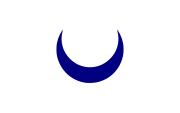User:Swiãtopôłk/sandbox
 | |
| Use | Civil and state flag |
|---|---|
| Proportion | 2:5 |
| Adopted | April 17, 1986 |
The flag used by the Santiago del Estero province in Argentine consists of five vertical stripes. The first stripe from the hoist side is light blue two tenths wide and white one tenth wide are symmetrical to the last two stripes: white one tenth wide and blue two tenths wide. The middle stripe is a red square four tenths wide and features a golden sun with a red Cross of Saint James in the center. Light blue and white are the Argentine national colors, while red represents the Federalist Party to which the province owes its autonomy. The sun refers to the Sun of May present on the national flag. The cross represents the Catholic and Spanish heritage of the region.
It is the oldest continuously used provincial flag in Argentina, approved by Law No. 5535 passed on 17 April 1986, although the flag was designed the previous year.
Flags of the Kingdom of Beni Abbas
[edit]Draft:Flags of the Kingdom of Beni Abbas
Flag of Kingdom of Tlemcen
[edit]The Kingdom of Tlemcen was a late medieval Islamic kingdom ruled by the Zenata Berber Zayyanid dynasty in what is now the northwest of Algeria[1][2]. During the existence of this country, national flags in the modern sense were not used. There are no Arabic sources describing the flags used by Tlemcen, however Iberian sources show similar blue and white banners with a crescent moon. The white banner with blue crescent is consistently served by Angelino Dulcert (fl. 1320s) as well as the authors of the Book of All Kingdoms (dated to c. 1385) and the Catalan Atlas (often conventionally dated 1375)[3][4]. Early 14th century genoese cartographer Pietro Vesconte showed the banner as white with a red crescent and three fringes. Lopo Homem on a map from 1519 shows a coat of arms with a blue shield and a golden crescent. A 16th century map created 8 years after the fall of Tumcan and 3 years after the death of its last ruler in Spanish Oran[5] shows inverted colors, i.e. white crescent on a blue background[6]. The flag of the Kingdom of Tlemcen shows the earliest use of the crescent in present day Algeria. Widespread use of the crescent in Islam develops during the 14th to 15th century.[7] Algeria now uses the crescent along with the star in national flag.
Gallery
[edit]-
Flag of Kingdom of Tlemcen on according Iberian sources.
-
Flag from Algiers on Pietro Vescontes' map.
-
A currently popular version of the flag.
See also
[edit]References
[edit]- ^ "Abd al-Wadid Dynasty | Berber dynasty". Retrieved 2016-07-22.
- ^ Appiah, Kwame Anthony; Gates, Henry Louis, eds. (2010). Encyclopedia of Africa. Oxford University Press. p. 475. ISBN 9780195337709.
- ^ Ferandez-Armesto, F.F.R. (1995). The European opportunity. Aldershot, Great Britain ; Brookfield, Vt. : Variorum. p. 291. ISBN 978-0-86078-501-9.
The Catalan Atlas is conventionally attributed to 1375, because that year is used as the starting-point for the computation of the Golden Number, but 1376 and 1377 are also mentioned in its accompanying texts; it conforms closely to the description of such an atlas in the French royal library catalogue, dated 1380 [...] The Catalan Atlas can be assigned with some confidence to the late 1370s or the early 1380s.
- ^ The date "1375" is mentioned in several places in the map: Gunn, Geoffrey C. (15 October 2018). Overcoming Ptolemy: The Revelation of an Asian World Region. Rowman & Littlefield. p. 67. ISBN 978-1-4985-9014-3.
- ^ Bosworth, Clifford Edmund (1996). "The 'Abd al-Wadids or Zayyanids or Ziyanids". The New Islamic Dynasties: A Chronological and Genealogical Manual. Edinburgh University Press. pp. 43–44. ISBN 9780748696482.
- ^ Oxford, Bodleian Library MS. Canon. Ital. 143: https://digital.bodleian.ox.ac.uk/objects/2b9b61b9-9056-4bcf-8af1-62752309358c/
- ^ Pamela Berger, The Crescent on the Temple: The Dome of the Rock as Image of the Ancient Jewish Sanctuary (2012), p. 164f
[[Category:Obsolete national flags] [[Category:Flags of Algeria]
The following is a list of flags and banners related with Algeria.
kiedys jak bedzie wiecej zrodel
[edit]l
[edit]-
Australia
-
Australia
-
Australia
-
India
-
India
-
India
-
India
-
India
-
India
-
iran
-
Iran
-
Ottoman
-
Ottoman
-
Ottoman
-
Ottoman
-
Ottoman
-
Ottoman
-
Ottoman
-
usa
-
usa
-
usa
-
Kaz
-
Kirgistan
-
Italy
-
Peru
-
Poland
-
Poland
-
Czechia
-
UK
-
Venezuela
-
Albania
-
Albania
-
Albania
-
Albania
-
Albania
-
Albania
-
Albania
-
Albania






![[1][2][3][4]](http://upload.wikimedia.org/wikipedia/commons/thumb/c/c3/Flag_of_Barbuda.svg/120px-Flag_of_Barbuda.svg.png)








































